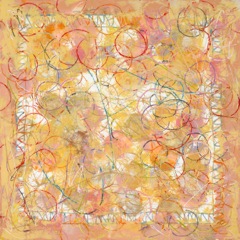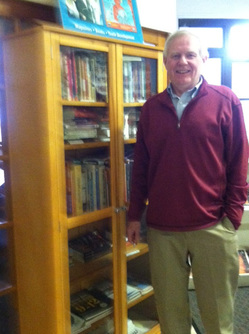November 2013 Archives
Dwight School, a 141-year-old independent International Baccalaureate (IB) World School located on Manhattan's Upper West Side, received a 2013 Blackboard Award for Schools recognizing excellence in education, with a special citation for community service and citizenship.
This week, Dwight Chancellor Stephen Spahn accepted the award at a ceremony attended by Chancellor of the New York City Department of Education Dennis Walcott and NYC Council Member and Manhattan Borough President-elect Gale Brewer.
"This is an honor for Dwight, made even more special because we're being recognized for community engagement.
Community is one of the three pillars of a Dwight education, alongside personalized learning and global vision. At Dwight, we're dedicated to creating thoughtful global citizens and the next generation of innovative global leaders, and we believe that leadership begins close to home. In this case, just across Central Park," said Chancellor Spahn.
Dwight was recognized for the innovative community partnership the School forged with the 1199 Housing Corporation, owner of the East River Landing cooperative in East Harlem. Located at First Avenue and 108th the coop was home to a recreational facility that lay dormant for 17 years because shareholders were unable to afford its upkeep.
Dwight School, in search of expanded athletic facilities, envisioned the possibilities for this untapped resource. Rather than raise millions of dollars through a capital campaign to build a sports facility, Dwight refurbished the 40,000-square-foot center to bridge community boundaries, bringing shared value to both Dwight students and the 6,500 coop residents who now use the Dwight School Athletic Center for free. With a 25-yard indoor pool, regulation-size high school gym, two roof-top tennis courts, a weight room and more, the facility, which opened in June, is quickly becoming a vibrant center for health, fitness, and youth leadership programs benefitting many thousands of New Yorkers.
"I am delighted that Dwight has re-opened the space for use by East Harlem community residents," said Chancellor Spahn, the longest-serving school leader in New York City. "I am equally delighted that we can provide our students with the facilities they need to excel in sports. In fact, our goal is to help students excel in whatever pursuit they choose, from athletics to the arts, and from technology to youth service leadership. We call this 'igniting the spark of genius in every child'."
Dwight School graduates attend leading colleges and universities around the world, including Harvard, Yale, Princeton, Stanford, MIT, Oxford.
Founded in 1872, Dwight (www.dwight.edu) was the first school in the US to offer the comprehensive International Baccalaureate curriculum for students from preschool through grade 12. It is the flagship campus of The Dwight Schools, a global network of programs and campuses in London, Seoul, Beijing, and on Vancouver Island. #
By Joan Baum, Ph.D.
 Linda Sirow, who has a piece in a juried show at the Richard D'Amato Gallery in Sag Harbor, New York, continues to impress with her lovely abstract encaustics. The competition, a benefit for The Retreat, a well-known shelter for abused women and children on the East End of Long Island, drew 200 applications from all over the world from artists working in various media. Of course, Sirow is pleased that her work was one of 25 selected submissions, and delighted that 100 percent of the entry fees go directly to support the work of this important organization. And how serendipitous that Sirow gets major attention at the top of the stairs of the two-floor gallery, and that the piece is next to nothing else like it around . Linda Sirow, who has a piece in a juried show at the Richard D'Amato Gallery in Sag Harbor, New York, continues to impress with her lovely abstract encaustics. The competition, a benefit for The Retreat, a well-known shelter for abused women and children on the East End of Long Island, drew 200 applications from all over the world from artists working in various media. Of course, Sirow is pleased that her work was one of 25 selected submissions, and delighted that 100 percent of the entry fees go directly to support the work of this important organization. And how serendipitous that Sirow gets major attention at the top of the stairs of the two-floor gallery, and that the piece is next to nothing else like it around .
The colorful 24" x 24" square of layered oil and beeswax on wood is called "Two Step" because she felt a kind of "dance-like" movement guiding her when she was painting it, she says, a sense that helped determine the placement of her signature slightly open circles. Indeed, "Two Step" exudes a kind of pulsing luminescence that suggests interacting images slightly in motion, nothing fixed--a bit like her life, which at one point she describes as having "so many moving parts," some not as readily apparent as others. A close look at "Two Step" reveals a subtlety of form and technique: solid circles and one-inch perimeters that have been painted over and sit under the bolder circular brushstrokes, and with slight gouge-like indentation that creative depth. For those following the evolving work of this decorative artist, who also teaches art at Dalton Middle School, "Two Step" may seem bolder than usual, though Sirow still keeps to a restricted palette-here, a warm assemblage of shimmering yellows, pinks, mauves, and corals under thin lines of cooler hues-slashes of blue or green that subtly contrast with the overall pastel effect.
Over the years Sirow has found herself increasingly attracted to encaustic, or hot wax painting, and likes to experiment with its layering effects, noting that between oil and wax, the relationship can never be 50 / 50-one or the other must predominate and for her, the winner is wax. Why circles? She smiles, she likes the geometry-circles and squares-- though she adds that she has also been looking at aboriginal work in Australia where dots and circles--folk patterns and symbols--constitute much of the art. She has also been looking at related work online, and she sometimes finds herself attracted to craft items, such as bowls she saw recently that were made out of knitted string, whose textured quality seemed consonant with her own predilections.
Her openness to creative impulses affects her teaching as well, where she encourages her students to see that working in clay is more than throwing on a wheel. A recent assignment included having her middle-school students bring in found materials--wire, objects--to include in their clay sculptures in a way that would enhance appreciation of repetition and form. One student, however, for whatever reason, was averse to working in clay and wanted to use crayons, melting them with a hot glue gun. Since the girl was going to explore the idea of the assignment, anyway Sirow supported her desire to do something different. The result was an "interesting" sculpture that had been built out of melted colored crayons originally formed into Lincoln-log-like shapes-an imaginative take on the assignment. More significantly, the girl had been led to pursue a "passion" for and "excitement" about art. The finished piece gave the girl a "confidence" that followed her into high school.
So much of the education world now succumbs to curricular cut backs, and the first areas to go are always art, Sirow understandably laments. But when you cut away creative endeavor, it's hard, if not impossible, to go back and resurrect it later in life. Conversely, when it's there, and encouraged, it's there forever, even if not immediately recognizable. Her own oldest son, who had always loved drawing, now works in the financial world and evaluates business ventures "creatively." His visual art experiences in high school paid off, and he is now also involved with nonprofits in the arts. Needless to say, Linda Sirow loves her work at Dalton where for close to 20 years, she preaches what she practices and continues to practice what she loves.#
This session is for adults with Attention Deficit Hyperactivity Disorder (ADHD), their spouses, and parents of children with ADHD.
When: 6 Thursdays, Jan 16-Feb 20, 7-9 pm,
Entry fee: $300/$350
With Dr. Mark Bertin
Developmental Pediatrician and Author of The Family ADHD Solution
ADHD affects the quality of people's lives in a myriad of ways including increased stress levels, struggles at work and school, and challenges in personal relationships. Recent research shows that mindfulness meditation and related stress-reduction techniques may improve executive function and attention, reduce stress, promote cognitive flexibility in problem solving, foster emotional well-being, and mitigate ADHD effects through enhanced self-awareness and self- regulation. Each session of this class includes mindfulness exercises taught in a manner suitable for those with attention issues as well as those new to meditation. The class will also include education about ADHD, from the neuroscience to the impact on day-to-day life.
The event is co-sponsored by the ADD Resource Center.
Movie Review by Jan Aaron
 Before you get the mistaken impression that Geography Club is a about a nerdy high school group that studies the shape of the earth, it's not that at all: Goodkind High School's Geography Club is a secret society with a name so nerdy it keeps the curious away. It's actually a group of teens trying to figure out their place in the social terrain. Geography Club, based on the first novel in Bret Hartinger's critically acclaimed best selling Russel Middlebrook series is a smart, funny film adapted for the screen by twin filmmakers, the Entin brothers- Gary (director) and Edmund (writer). The film will open in 15 cities across the United States, on November 15, and at the same time will be available on select cable and Internet platforms.
The teens' objective is to use their seemingly boring club no one will want to join where they can hang out and just be themselves without enduring the fitting in struggle of virtually everyone's high school experience. Their goal is to find out who they really are.
The movie's hero is gay - a gay athlete in love with the captain of the football team, who also is gay? This is not to mineralize the conflict in this film: the team captain in fact struggles to reconcile his sexual orientation with his "identity" as a school jock. In the 90's, the film might have centered on the jock's struggling to find acceptance in a narrow-minded community, it's now about accepting yourself. The filmmakers have said they were not making a film to that shocked or enraged, but one that entertained. They hope to define the new normal in teen life.
This is story about a teen group who step out of the box to be themselves. You should definitely step into a theater to enjoy yourself.
By Lisa K. Winkler
The five clocks on the wall above Youth Communication's door are set to the same time. Unlike clocks representing time zones around the world found in professional newsrooms and hotel lobbies, these clocks show the time in New York City's boroughs: The Bronx, Brooklyn, Manhattan, Queens, and Staten Island.
Next to the door stands an overloaded bookcase; its shelves teeming with titles written by some of nearly 3,000 alumni of Youth Communication's teen journalism programs. Writers who've participated in YC's programs include the novelist Edwidge Danticat, and Rachel Swarns, newspaper reporter and author.
 Founded by Keith Hefner (see photo on right) in 1980, Youth Communication produces two teen-written magazines: YCteen, for secondary school students, and Represent, by youth in foster care. Through personal essays, teens share their stories about issues other teens want to read about. Creating what Hefner calls "service journalism," YC's original goal was to dispel the media images of urban teens as wanton and violent. "We also wanted to show kids the world beyond their block, and how they could overcome the challenges they faced and transform their lives," said Hefner. Founded by Keith Hefner (see photo on right) in 1980, Youth Communication produces two teen-written magazines: YCteen, for secondary school students, and Represent, by youth in foster care. Through personal essays, teens share their stories about issues other teens want to read about. Creating what Hefner calls "service journalism," YC's original goal was to dispel the media images of urban teens as wanton and violent. "We also wanted to show kids the world beyond their block, and how they could overcome the challenges they faced and transform their lives," said Hefner.
From the magazines, printed on newsprint, YC's products grew to include more than 30 anthologies, created from teen articles, that include titles such as "Real Jobs, Real Stories," "Teen Guide to Sex (without regrets)," and "Vicious: True Stories by Teens about Bullying." Following the books, YC produced leader guides for teachers, counselors and other supervisors of youth programs to assist them in using the stories with their teens. Each magazine sponsors an essay writing contest each issue that attracts entries nationwide. The magazines, and several of the anthologies, have won top awards from the Association of Educational Publishers.
Hefner began advocating for youth voices when he was a teen himself in Ann Arbor, Michigan.
"It was the late 1960's. There was no Internet; no Facebook. There were thousands of teens publishing underground newspapers around the country. We'd get stacks of them and shuffle them and then send out packs to the editors so they would know what everyone else was doing. From that, we started a newsletter for teen activists," he said, referring to two friends who helped him.
When he moved to NY in 1979, he realized his newsletter readers were now adults; many were working in youth programs and subscribed to keep in touch with youth issues and to use the stories with teens in their programs. This evolution is similar to the challenges YC faces today with its programs and products.
"We're no longer just a youth journalism program," he said. Though YC remains committed to teaching students writing, essays may go through up to 10 draft; the focus has shifted to serving educators as people, especially youth, read less.
"It used to be we'd produce a magazine with a great cover and headlines and students would automatically read it. Our books were often the most stolen from classrooms," said Hefner, but now, kids aren't reading on their own, at all." Bundles of magazines would go left unopened on school doorsteps. But when the magazine or books were delivered directly to a teacher who then assigned the readings, students read non-stop.
"We realized we needed to market to the adults working with the kids," he said. There are currently 690 teachers who order bulk copies of YCteen. (It's free, because The New York Times donates the printing.) They use it to teach reading and writing, and in counseling settings. For example, some teachers use the YC materials to help introduce thematic units, or linked text sets. One teacher, Hefner recalled, recently used YC stories to introduce themes of family relationships in a unit that also included the Arthur Miller play, "Death of a Salesman." YC already provides free Common Core-linked lesson plans that accompany YCteen magazine, and the staff hopes to assist teachers in linking more YC materials to curriculum requirements in the future. #
|
|
|

 Linda Sirow, who has a piece in a juried show at the Richard D'Amato Gallery in Sag Harbor, New York, continues to impress with her lovely abstract encaustics. The competition, a benefit for The Retreat, a well-known shelter for abused women and children on the East End of Long Island, drew 200 applications from all over the world from artists working in various media. Of course, Sirow is pleased that her work was one of 25 selected submissions, and delighted that 100 percent of the entry fees go directly to support the work of this important organization. And how serendipitous that Sirow gets major attention at the top of the stairs of the two-floor gallery, and that the piece is next to nothing else like it around .
Linda Sirow, who has a piece in a juried show at the Richard D'Amato Gallery in Sag Harbor, New York, continues to impress with her lovely abstract encaustics. The competition, a benefit for The Retreat, a well-known shelter for abused women and children on the East End of Long Island, drew 200 applications from all over the world from artists working in various media. Of course, Sirow is pleased that her work was one of 25 selected submissions, and delighted that 100 percent of the entry fees go directly to support the work of this important organization. And how serendipitous that Sirow gets major attention at the top of the stairs of the two-floor gallery, and that the piece is next to nothing else like it around . Before you get the mistaken impression that Geography Club is a about a nerdy high school group that studies the shape of the earth, it's not that at all: Goodkind High School's Geography Club is a secret society with a name so nerdy it keeps the curious away. It's actually a group of teens trying to figure out their place in the social terrain.
Before you get the mistaken impression that Geography Club is a about a nerdy high school group that studies the shape of the earth, it's not that at all: Goodkind High School's Geography Club is a secret society with a name so nerdy it keeps the curious away. It's actually a group of teens trying to figure out their place in the social terrain.